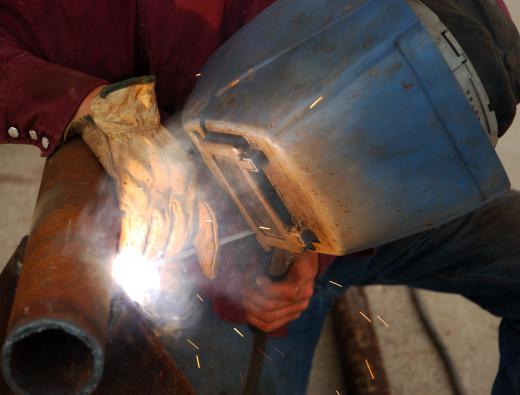A socket weld is a weld used when attaching socket flanges to iron pipe. The socket flange allows two different-diameter pipes to be connected together and retain a high-flow characteristic. Exactly as the name implies, the socket weld actually welds a pipe into a recessed socket fitting in the socket flange, creating a high-strength union capable of withstanding high pipeline pressure without connection failure. Once the pipe is pushed into the flange, the socket weld is used to surround the outside diameter of the pipe, fusing the two components together as a single component. The weld varies from a common butt weld in that it surrounds a small-diameter pipe where it enters a larger-diameter pipe, instead of simply joining two equally-sized surfaces together.
When making a socket weld, it is imperative that the inner pipe not be pushed completely into the larger pipe so that it bottoms out in the socket. Failure to pull the inner pipe slightly off of the bottom surface of the socket can result in stress failure of the socket and the weld. This damage occurs when the heat from the welding procedure causes the two pipes to expand. Without a small gap between the bottom of the inner pipe and the bottom of the socket, the two could make contact and push against each other, thereby compromising the integrity of the socket weld.

The actual type of weld used when making a socket weld is called a fillet weld. With the smaller pipe inserted the proper depth into the socket, a fillet weld is placed around the outside of the smaller pipe while also contacting the larger outside diameter of the socket. This socket weld creates a leak-proof and sealed high-pressure fitting suitable for the transport of air, liquids and gasses. This type of joinery is commonly used on smaller-diameter pipe, while the larger-diameter pipe commonly uses a butt weld to make connections.

In a butt weld, the two halves or pipes are beveled slightly with a grinder to create a V when placed tightly together. The welder then places the butt weld in the V, essentially filling the gap with weld and creating a solid joint between the two pipes. There is typically no grinding in the creation of a socket weld, though there remains some prep work to be completed prior to making the weld. Users can prevent the inner pipe from bottoming out in the socket by measuring and scribing a reference line around the joint or by installing a permanent fitment tool designed to remain inside of the joint and then proceeding with the socket weld.
